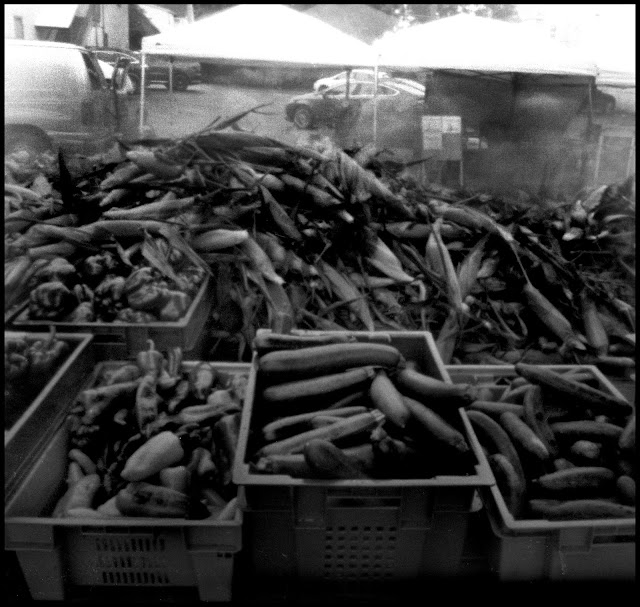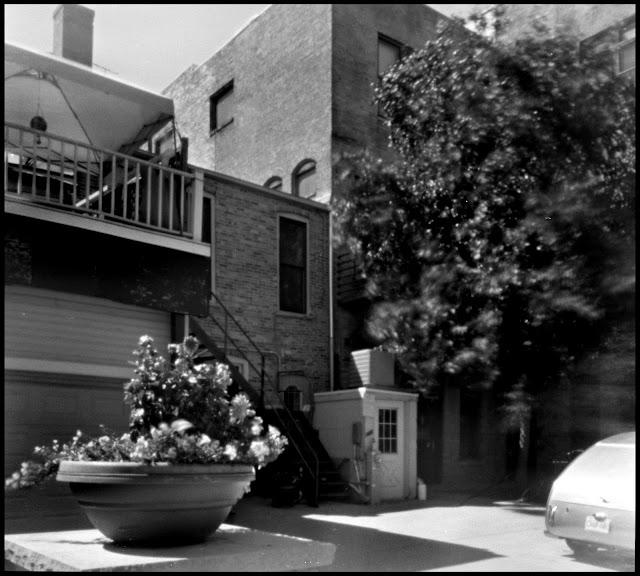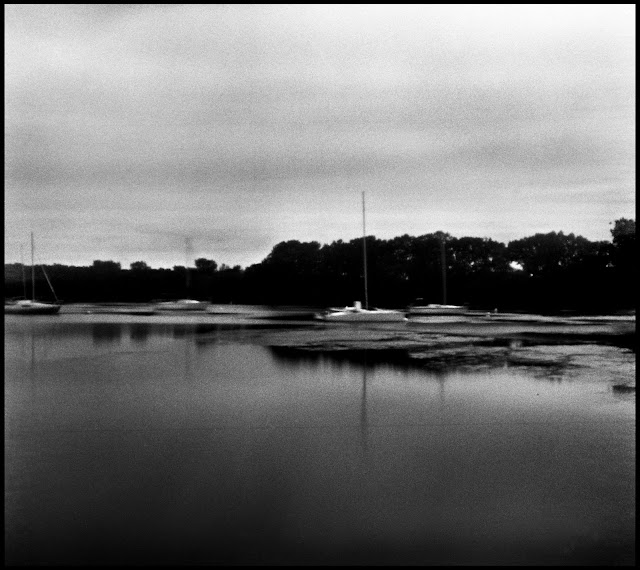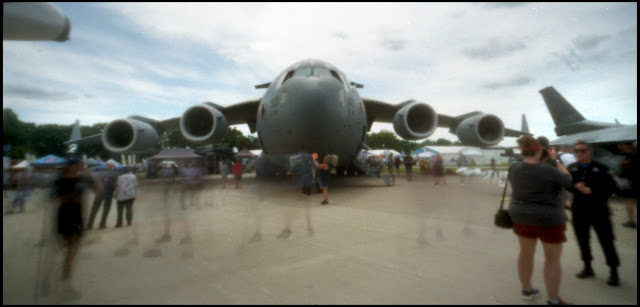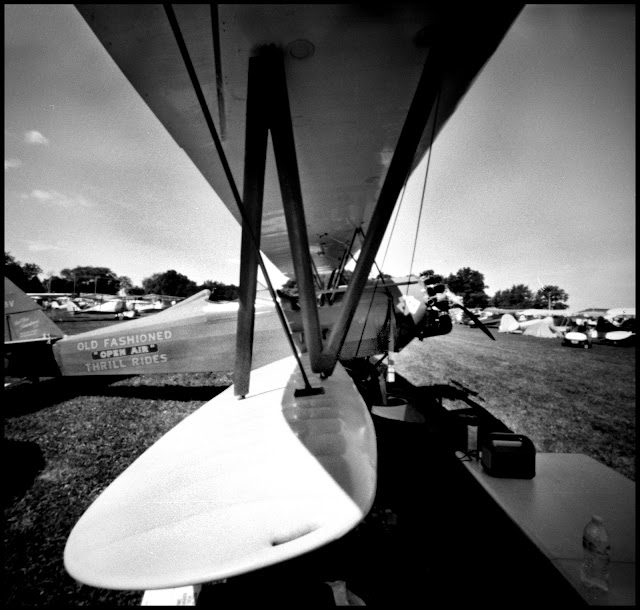I've occasionally mentioned why you might have heard of Oshkosh, Wisconsin before. If you've got a kid, Oshkosh B'Gosh is probably visible somewhere on their clothing. If you're in the military or utility truck business, it's
Oshkosh Corporation, aka Truck. If you're interested at all in aviation, it's the
Experimental Aircraft Association's annual AirVenture Fly-in at Wittman Field.
According to Google, the biggest airshow anywhere. A stewardess once asked me where I was from and then told me her husband was a 747-400 pilot and they came to Oshkosh every year in their Beechcraft Bonanza. It lasts a week and it's downright encyclopedic.
As I explained to one curious aviator, pinhole is especially appropriate to this event because there's nothing between the subject and the film except air. It's air photography. He replied that it also was appropriate because it's the Experimental Aircraft Association. Two other very well-equipped photographers with accessory vests asked me if I was experimenting with pinhole photography. Among a bunch of people who build airplanes, it was strange to hear they were impressed I could make a camera out of cardboard. One of them couldn't remember the term and asked me if it were a peephole camera.
My fascination with the basics of aviation is similar to my fascination with physics of pinhole photography. So, the top of the wing is curved more than the bottom. In order for the air to get over it, it has to go faster because it's now farther than it is at the bottom. According to Bernoulli, that reduces the pressure at the top which allows this great huge machine to get sucked up into the sky. Really!
I took three cameras with me. Long John Pinhole, recently resurrected with new Gilder Electron Microsope apertures, taking the narrow angle, The Variable Cuboid with the moderate wide-angle 60mm front and it's interchangeable front option and continuously adjustable rising front so I'd sound a little sophisticated with the home builders, and the Hazy Rabbit at ultrawide 30mm, because I think it's funny,
After parking by the Museum, not realizing there were busses to the convention grounds, I walked about a mile with a generally cheerful group who also made the same mistake.
I went directly to the big stuff in Boeing Plaza, the central showplace on the grounds, My first confrontation was with the landing gear of a C-17 GlobeMaster.
The tail is about five stories tall. (Later edit: Oops! Both of those are the KC-46 aerial refueling tanker. Still about as high, but not as stout as the C-17)
Powered by four Pratt & Whitney F117-PW-100 turbofan engines. When I encounter a hotel HVAC system that's really noisy, I always joke it was made by Pratt & Whitney, but nobody ever gets it. They would at EAA.
As is very common throughout the convention, the air crew sat in the shade of the wing and interacted with the crowd.
There was also the Boeing 777-200ER ecoDemonstrator, and Delta's Team USA Airbus A330neo, famous for flying Olympic athletes to Beijing last year. There were tours of all these planes going on but the lines were long and exposures inside would be impossible. A guy from Boeing on a PA system joked that his Triple Seven didn't need winglets like the Airbus.
Looking down the throat of a Rolls-Royce engine on the Airbus.
Inside the business end of the Rolls-Royce. Just to my left, a father was explaining to his teen-aged son the difference in where the fuel was ignited compared to the Triple Seven right behind it.
I don't think Art Deco influenced the nose of the B-29, did it?
From our house five miles north of the airport, except for hearing the aerobatic performers and the really loud military jets during the airshow, you can hardly tell anything is going on. The main sound over the city is the rumble of the engines of the B-29 which they seem to fly around about once a day, and the constant roar of a Ford Trimotor and a B-25 they sell rides on.
It's hard to capture the scale of the event. Over 10,000 planes are at Wittman Regional Airport. They're parked everywhere. Think of all the open space at your local airport, then fill that with airplanes wingtip to wingtip, arranged by type of aircraft. I think this might be a Cessna to Beechcraft transition.
The Vintage section includes several rows of mono and biplanes with giant rotary engines. I picked this one because it was white with the door casually left open. It's also got a small hose running from the engine to a fuel can on the ground. It turns out it's
kind of a famous plane in 1930's air racing.
Close up of one those beefy looking engines,
Detail of the cylinders on another plane.
Cockpit of one of the vintage planes with the original joy stick.
This one attracted my attention because of the the cushy looking tires and the 360° transparent cockpit including the doors.
There's a seaplane base over on Lake Winnebago on the other side of the airport, but this one could go either way. There were also several
DC3-C47's down here.
The landing gear under the wing.
At the south end of the airport, the ultralights have their own space including a grass landing strip with bleachers where they have to make a sharp turn around a grove of trees just before the runway. The announcer was waxing nostalgic about the early days when people use to strap lawn mower engines to their back. I love all the cables which control the shape of the wing rather than mechanical control surfaces.
Airplanes with their long wings and slender fuselages are a challenge for a square format camera, so I was kind of relieved to encounter this little fuel booth.
A movie star airplane. Actually it's another copy of the plane from the movie The Great Waldo Pepper in the EAA Museum's collection that they painted the same way. Another extravagant display of cables for structural as well as control functions.
An abstract of sun, shadow, rivets and cables on a homebuilt (yes, that's one word). Experimental Aircraft is the actual FAA classification.
The engine looks very like something you'd find on a John Deere tractor from that era.
The minimalist rear cockpit. I love the folded up charts and the holes to put your feet through to control the ailerons.
The rudder and elevators connected directly to the stick with cables of course.
Very modern looking aerodynamic landing gear on another homebuilt.
An unusual delta winged homebuilt.
A Lycoming engine on another vintage looking experimental aircraft.
The VariEze with it's distinctive front canard is very popular. The prototype by
Burt Rhutan of round-the-world-non-stop airplane fame was first shown at Oshkosh in 1975 with plans available the next year. The original had the same engine as my 1973 VW Super Beetle.
A family in the shade under the wing of their airplane.
Some of the hydraulics which fold the wings of a WWII F4U Corsair which allowed more of them to be stored on an aircraft carrier.
Andy was in the first class of Young Eagles where local kids and a parent attended several Saturday sessions culminating with their first ride in an airplane. This Ford is the first plane Andy ever flew in. The parents didn't get a ride, but I eventually got a free ride in a Fokker version when I was in a city leadership program several years later.
Anybody want to buy a private jet? Honda had one on display alongside a motorcycle and a lawn mower. This was all behind a low partition. I wonder what you had to do to get inside to get the sales pitch?
Before I left in the morning, I worried aloud that I might not find anything I wanted to photograph. Sarah responded that they'd probably have the back of a tent I might be interested in. She was right.
I saved my last frame for a selfie at the NASA exhibit. Most of the stuff was on Aeronautics. They did have a large Hubble display, but no mention of JWST. Just to sit down for a bit, I accepted the invitation to experience a pilot's chair that was connected to a display which swayed and twisted like a ride at Disneyland as the plane moved. The guy from the Graphics and Visualization Lab said it was cool that with my camera, one opened the Hazy Rabbit's eye to make an exposure.
A wiggle of the wingtips to Heidi Reinke for giving me this opportunity.
The Hazy Rabbit has hand-drilled .23 pinholes 30mm from the film, one on the axis, and one 10mm above the axis. The 60mm front for the Variable Cuboid has a .30mm hand-drilled pinhole on an adjustable rising front. Long John Pinhole has .40mm Gilder electron microscope apertures 120mm from the film, one on the axis, and one 10mm above the axis. All take 6x6cm negatives. The film was Arista.edu 100 semi-stand developed in caffenol.










